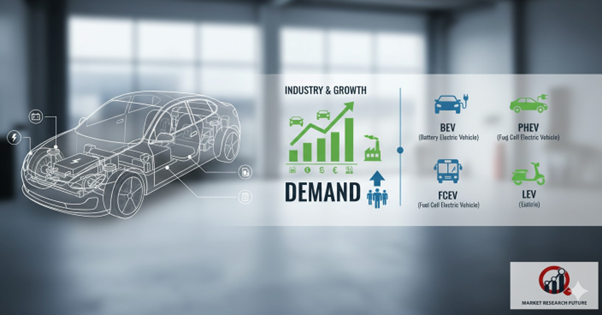Electric Vehicle – Mechanism, Industry and growth, Demand, Types of Electric Vehicle

The Introduction to the Electric Vehicle Market
For achieving sustainable development goals and offering technologically advanced products that serve both customer utility and industrial interests, electric vehicle (EV) production and distribution have witnessed a substantial rise in recent years.
The surge in demand is primarily driven by environmental awareness, technological innovation, and supportive government policies promoting clean energy.
Electric vehicles are broadly categorized into battery electric vehicles (BEVs), hybrid electric vehicles (HEVs), and plug-in hybrid electric vehicles (PHEVs). These segments include two-wheelers, passenger cars, and commercial vehicles, catering to diverse mobility needs across regions.
What is an Electric Vehicle?
An electric vehicle (EV) operates using an electric motor instead of an internal combustion engine that burns fuel to generate power. Due to the rising concern over air pollution and carbon emissions, electric vehicles have gained significant attention as a sustainable alternative to conventional automobiles.
EVs utilize batteries such as zinc-air, molten-salt, or lithium-ion to store and supply energy efficiently. By eliminating fuel combustion, these vehicles effectively tackle pollution and contribute to a greener future.
Mechanism: How Does an EV Operate?
Understanding the mechanism of EVs helps explain their growing demand. Electric vehicles typically use one or more electric motors powered by energy stored in rechargeable batteries.
Propulsion is assisted by traction motors, while advanced technologies such as regenerative braking systems (RBS) and turbochargers allow partial self-charging. The RBS converts kinetic energy lost during braking into electrical energy, enhancing efficiency and extending driving range.
Top Manufacturers of Electric Vehicles
- Tesla
With a global market share of around 28% and sales exceeding 179,000 units, Tesla continues to lead the EV revolution. Founded in 2003 by Elon Musk, the company focuses on three pillars: technology, design, and performance, while maintaining a zero-emission philosophy.
- Volkswagen
The German automaker delivered 212,000 EVs in 2022 and introduced nine new plug-in hybrid and electric variants. The ID.3 model alone sold over 56,000 units, followed by the upcoming ID.4 launch aimed at expanding global reach.
- BMW
BMW’s plug-in hybrid technology captures and reuses electric energy generated while driving. The BMW 530e iPerformance can travel up to 28 miles on a full charge. Owners also benefit from lower taxes and incentives due to reduced CO₂ emissions.
- Nissan
Nissan’s LEAF remains one of the most popular fully electric vehicles, offering features like Pro-Pilot Park, E-Pedal, and Intelligent Mobility systems. With its e-powertrain and lithium-ion battery technology, Nissan continues to innovate in the EV domain.
Regional Analysis
The electric vehicle market shows strong growth across major global regions. In North America, the US remains the leading market, supported by government incentives, expanding charging infrastructure, and Tesla’s dominance.
In Europe, countries like Germany, Norway, and the UK are rapidly transitioning to EVs due to strict emission norms and sustainability goals.
In the Asia-Pacific region, China leads globally in EV adoption, driven by domestic production incentives, while India and Japan are emerging as fast-growing markets with supportive government schemes like FAME II and EV30@30.
In Latin America and the Middle East & Africa, regions are witnessing gradual EV adoption, mainly through fleet electrification and investment in charging infrastructure.

Leave a Comment